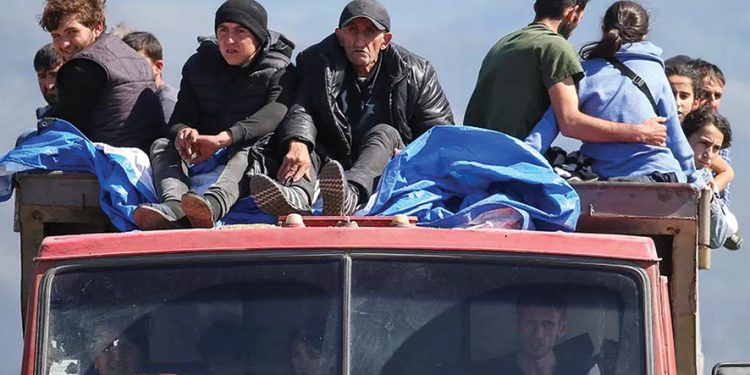In a week marked by rising tensions, Nagorno-Karabakh once again finds itself at the center of a conflict that threatens regional stability. Armenian Prime Minister Nikol Pashinyan sounded alarm bells, stating that Azerbaijan had been amassing troops near Nagorno-Karabakh and along the Armenian-Azerbaijani border in the past few days. According to him, the military-political situation in the region had deteriorated, and a recent confrontation near the border resulted in the tragic loss of three Armenian soldiers.
Pashinyan called upon the international community to respond swiftly, fearing that Azerbaijan was preparing for armed provocation. He emphasized Armenia’s commitment to implementing the ceasefire agreements reached during meetings in Brussels and Prara in 2021-2023.
The recent developments follow a history of conflict in the region. Nagorno-Karabakh, an ethnically Armenian enclave, declared itself independent in 1991, sparking a long-standing military conflict between Armenia and Azerbaijan. Despite multiple ceasefire agreements, including those mediated by Russia and the United States, the conflict persisted, resulting in thousands of casualties over the past two years.
Azerbaijan’s Ministry of Defense issued a statement, justifying its actions in Nagorno-Karabakh as anti-terrorist measures aimed at restoring the constitutional structure. They claimed that Armenian Armed Forces had initiated artillery fire, prompting a response.
Armenian Prime Minister Pashinyan vehemently denied having Armenian forces stationed in Nagorno-Karabakh, accusing unspecified external and internal forces of trying to drag Armenia into war. He asserted, “The armed forces of Armenia are not in Nagorno-Karabakh.”
The situation on the ground worsened, with reports of civilian casualties and injuries. The Ombudsman of the unrecognized Nagorno-Karabakh Republic, Gagam Stepaniani, reported civilian casualties, including a child, and injuries, while Azerbaijan alleged that Armenian intelligence and sabotage groups were responsible for a mine explosion that killed six of its Ministry of Internal Affairs employees.
In response to the escalating tensions, protests erupted in Yerevan, the capital of Armenia, with demonstrators demanding the resignation of Prime Minister Pashinyan, blaming his policies for the situation in Nagorno-Karabakh.
As the situation continued to deteriorate, ethnic Armenians in Nagorno-Karabakh agreed to a ceasefire proposal. This decision came after Azerbaijani forces reportedly captured several strategic locations and heights, leading to Russia’s proposal for a ceasefire. The self-proclaimed Republic of Artsakh released a statement accepting the ceasefire proposal offered by the command of the Russian peacekeeping contingent.
The ceasefire marked a turning point as Nagorno-Karabakh was set to return to Azerbaijani control. The truce went into effect on September 20, ending a two-day conflict that had seen significant military gains by Azerbaijan. Protests in Yerevan continued unabated, with demonstrators calling for Pashinyan’s resignation and a nationwide strike announced by opposition representatives.
Despite the ceasefire, the humanitarian situation in the region remained dire. Thousands of ethnic Armenians fled Nagorno-Karabakh, and Azerbaijani flags were raised in several settlements, indicating the shifting dynamics on the ground.
In response to the crisis, international efforts to provide humanitarian aid were initiated. The United States pledged $11.5 million for Karabakh Armenians’ humanitarian needs, while the European Union promised 5 million euros. Despite the challenges, the evacuation process from Nagorno-Karabakh to Armenia is ongoing, with thousands of people seeking safety.
In a bid to find a diplomatic resolution, Prime Minister Pashinyan and President Aliyev of Azerbaijan were set to meet in Granada, with the involvement of international leaders such as French President Emmanuel Macron and German Chancellor Olaf Scholz. While a peace agreement remains elusive, hopes for a peaceful resolution by the end of the year persist.
As of September 28, 53,629 people and 10,985 vehicles had left Nagorno-Karabakh. As the press secretary of the Prime Minister noted, 35,491 of the evacuated people are officially registered.
“As of 7am, 38 medical patients have been transported by air – in total, 349 patients have been transported to Armenia, both by air and by land,” said the spokesperson of the Prime Minister of Armenia, adding that the evacuation process in Armenia is going smoothly, although it should be noted that due to the large flow of people, there are queues.
Today, Azerbaijan arrested the former de facto leader of Nagorno-Karabakh, Ruben Vardanian, as he attempted to cross into Armenia proper. Ruben Vardanian became the head of the de facto government of the unrecognized Nagorno-Karabakh in 2022, and left this position in 2023. Vardanian lived in Russia for years, and in 2022 gave up his Russian citizenship and moved to Nagorno-Karabakh.
As more than 65,000 have fled Nagorno-Karabakh, the separatist republic will ‘cease to exist.’ The separatist government of Nagorno-Karabakh on Thursday announced that it will dissolve, and the unrecognized republic will thus cease to exist by the end of the year. Armenian officials said that already more than half of the population has already left.
By Mariam Gorkhelashvili














